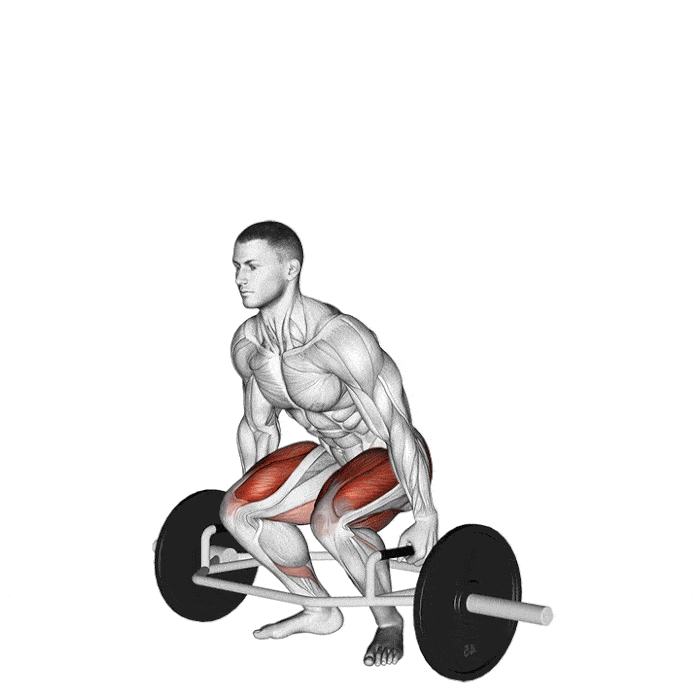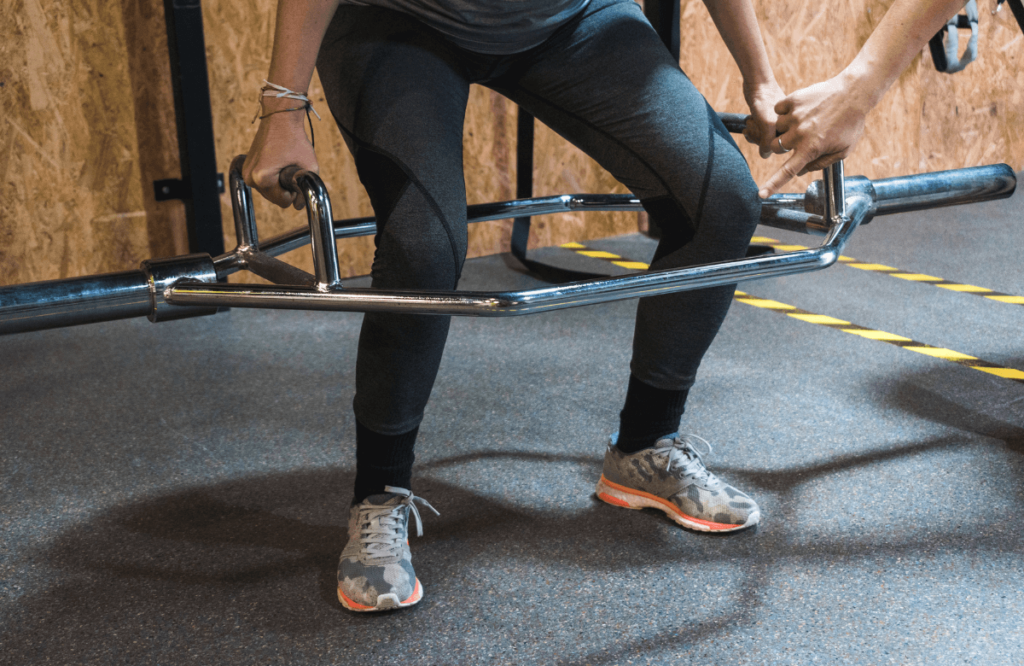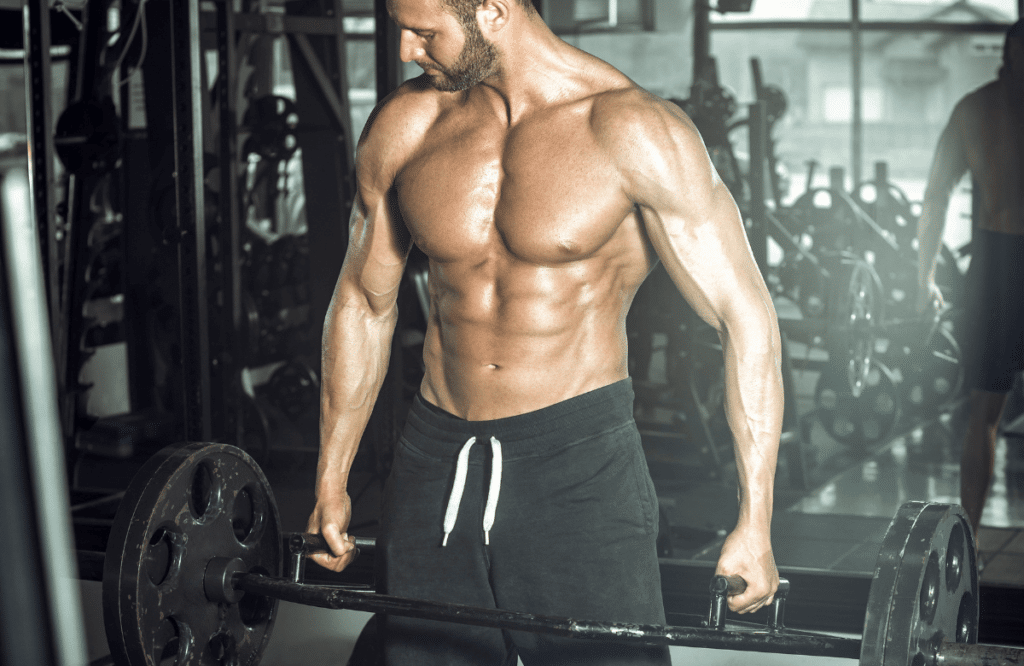Conventional deadlifts are one of the most famous exercises. However, when it comes to training for speed, quad development, and safety, trap bar deadlifts are the gold standard.
In this article, you’ll learn everything about the trap bar deadlift. See it as the complete guide for building strength, technique, and muscle.
Here’s a list of what we’ll cover:
– What are trap bar deadlifts?
– Differences between trap bars and conventional deadlifts
– How to do trap bars
– Common mistakes and benefits
– Workout samples for the trap bar deadlift
Time to dive in!
Jump to:
What Are Trap Bar Deadlifts?
Trap bar deadlifts are a deadlift variation that uses a trap bar (hex bar) with a hexagonal shape. This allows the lifter to step inside the enclosed bar and lift the weight.
It’s different from a conventional deadlift regarding the range of motion, muscles worked, and training purposes.
What’s The Difference Between Trap Bar And Conventional Deadlifts?
There are many differences between the trap bar and conventional deadlifts. Here are the main ones:
Different Bar
The trap bar deadlift requires a trap bar, also called a hex bar, due to its hexagonal shape. This form allows the lifter to step inside and lift the bar more comfortably.
The hex bar also has handles that can be set to low and high settings, depending on your intentions. However, you can only use a neutral grip (palms facing the outside of your quads).
The conventional or standard deadlift uses an Olympic straight barbell, the same one you’d use for a back squat, a clean, or a snatch.
This straight bar allows you to use different grips like overhand (both palms facing down) or a mixed grip (one palm facing the opposite of the other).

Different Range of Motion
The trap bar deadlift has a shorter range of motion than the straight bar deadlift. The reason is that the handles on the trap bar set you at a higher position, reducing the distance from the ground to the lock-out position.
Since the straight barbell doesn’t have handles, it puts you in a lower position with more travel distance.
A longer range of motion (conventional deadlift) means your muscles get more stretched, creating more muscle growth. A shorter range of motion (trap bar deadlift) is more strength and speed biased.
Trap Bar Deadlift Is Easier To Learn
The trap bar deadlift sets the body into a more upright position, making the vertical trajectory easier. This variation works great for beginners because they only need to think of gripping the bar and standing up.
With the regular deadlift, there’s more to pay attention to. The high hip hinge puts the torso in a forward leaning position which can be hard to master for some people.
The trap bar is perfect for beginners, the elderly, or people coming off from a back injury. It can help them work the posterior chain without putting much stress on the spine.
Trap Bar Deadlift Is More Sport-Specific
Unlike the conventional deadlift, if you’re a sports athlete, you need to find the best way to increase muscle and strength while keeping a low injury risk.
The trap bar allows a more vertical path, ideal for speed, power, and vertical training. Those exercises translate better to sports like sprinting, basketball, football, volleyball, and baseball.
Although you can train those variables with a conventional bar, it’s no way near the commodity that the trap bar provides.
Trap Bar Deadlift Has A Lower Injury Risk
Most deadlift injuries come from lousy technique, weak posterior chain, too much volume, or poor warm-up. This is more the case with conventional deadlifts.
However, the trap bar deadlift is easier to learn, more comfortable for your spine and has less range of motion. That makes it safer for your spine health and more suitable for beginners or other fragile populations.
How To Do A Trap Bar Deadlift?

The trap bar deadlift variation is a more precise movement than the traditional one. However, here’s a step-by-step guide that will help you master the technique and set you in the right direction.
- Put the weight on the trap bar.
- Step inside the barbell
- Set your stance in the same way as you would typically deadlift
- Hinge your hips and grab the sets of handles
- Squat down until you’re in a half-squat position with an upright torso and a neutral neck.
- Push the floor away to stand up
- Control your way down, bending your knees and hips
- Stop once the bar has returned to the floor and reset it for the next rep.
Practice with an empty trap bar or will lighter weights until you’re comfortable with the technique and your body is ready for the heavier loads.
Trap Bar Deadlift: Common Faults And How To Fix Them
Although the trap bar deadlift is easy to learn and has a lower injury risk, some faults could jeopardize your gains. Having a proper form is a prerequisite for maximizing your gains.
Knees Caving In
It’s common to watch people collapsing on their knees right after they begin to lift the bar. This could mean a weak gluteal musculature or a poor mind-muscle connection.
Although this isn’t inherently dangerous, it could indicate a power leak, leaving you with gains on the table.
To fix it, drive your knees slightly outwards as you go up. This will recruit and activate your glute fibers, helping keep the knees from collapsing.
Rounded Back
A rounded or “turtle” back is the most typical fault for deadlifts. Although keeping an upright torso with the trap bar is easier, it’s still prevalent in some beginners.
A rounded back could increase your risk of injury if the heavy load is too much for your spine to handle.
To prevent this, drive your shoulders back and stick your chest out. Brace your core and hold the position throughout the entire range of motion.

Looking Up
Looking up while lifting the trap bar puts unnecessary tension on your neck, which could increase the chances of injury.
Before lifting the bar, lower your chin and think of your neck as an extension of your torso. This will help you keep a neutral and safer position for your spine and neck.
Benefits Of The Trap Bar Deadlift
Some of the top benefits of the trap bar deadlift are the following:
Ideal For Beginners
Hex bar deadlifts are a favorite for beginners and people with poor muscle coordination. The bar path is primarily vertical, which makes it easier to understand and replicate.
Some individuals need little to no instructions before lifting the weight. They intuitively step inside the bar, grab it by the handles and stand up.
More Quad Activation
Compared to the standard, the trap bar deadlift has more knee flexion in the starting position. This automatically creates more muscle recruitment from the quads to extend the knee during the lift-off.
On the contrary, the conventional deadlift has a more hip hinge, which emphasizes other muscles like the glutes instead of the quadriceps.
Safer For Your Spine
A more upright torso means that your spine doesn’t take as much load as it would with a conventional barbell or Romanian deadlift.
Besides having a more upright position, the center of mass in the trap bar deadlift is more in the middle. This enables a more comfortable and safer place for your spine, even if you’re lifting heavier loads.
Improve Speed And Power Output
Using a trap bar allows you to move faster and more explosively on each rep. It also allows you to jump, which is crucial for developing speed and power output.
The torso positioning sets a more vertical trajectory than the regular deadlifts where the hips and torso are further away from the center of mass.

Muscles Worked In A Trap Bar Deadlift
The hex bar deadlift is considered a compound exercise because it simultaneously targets several muscles with different degrees of muscle activation.
The majority of them are leg muscles. However, the traps and lats also play a significant role in upper body stability.
Glutes
The gluteal muscles are a three-muscles group formed by:
– Gluteus maximus
– Gluteus medius
– Gluteus minimus
These muscles are responsible for extending the hips (on the way up), externally rotating, and adducting the femur, keeping the knees from caving in.
Although the traditional barbell deadlift recruits more muscle fibers from the glutes compared to the trap bar, it’s still a terrific exercise for developing muscle growth in that area.
Hamstrings
The hamstrings are located in the back of the leg. They are a four-muscle group:
– Semitendinosus
– Semimembranosus
– Biceps femoris (long and short head)
The hamstrings are the primary knee flexors, although they aid in hip extension and internally rotate the leg when the knee is bent.
Since the trap bar deadlift is a hip-dominant exercise, muscles like the glutes and hamstrings receive essential stimuli.
Quadriceps
The quadriceps are a four-muscle group located in the front of your leg. These are:
– Vastus lateralis
– Vastus medialis
– Vastus intermedius
– Rectus femoris
The quad muscles are one of the body’s largest and strongest muscle groups. They are mainly responsible for extending the knee (opposite of the hamstrings) and flexing the hips with the help of the psoas muscle.
Trap bar deadlifts are the variation with the greater quad activation compared to other types of deadlifts like sumo, Romanian, and conventional barbell deadlifts.
Trap bars are more effective in increasing quadriceps strength, making them a solid alternative for sport-specific training like jumping and running.
Erector Spinae
The spinal erectors (erector spinae) are long muscles running vertically through the back. Their primary action is to extend the spine, but they also help in hip extension in conjunction with the glutes.
These muscles are responsible for keeping a neutral lumbar spine throughout the entire range of motion and are a crucial component of a healthy posterior chain. The stronger your spinal erectors are, the lower the risk of injury.
Traps And Lats
The traps (trapezius) are a long muscles with three portions and slightly different actions, such as the following:
– Upper traps (elevate the shoulders and scapula)
– Mid traps (retract the scapula, bring them closer to each other)
– Lower traps (lower the scapula)
Because of its close relationship with the shoulder and scapula, it plays a crucial role in stabilizing the torso during deadlifts.
The lats (latissimus dorsi) are the widest muscle group in the body. They spread laterally from the mid back to the sides of the ribcage, reaching to the arm bone. Its principal function is to flex the shoulder (bring it down and back) and internally rotate the humerus (arm bone).
Like the traps, it’s a vital ingredient for keeping the torso rigid, especially when lifting heavy weights.
How To Include Hex Bar Deadlifts In Your Training
You can include hex bar deadlifts in your training for different purposes, such as speed, hypertrophy, and strength.
Speed
An essential for training speed and velocity is keeping the weight light, the movement fast, and the rest long. Those three variables are the foundation of practical speed training. Here’s a sample workout:
A1) Trap Bar Deadlift for speed (40-50% of your 1 rep max)
A2) Jump Squats
A3) Box Jumps
3 sets, 6-8 reps, 2-3 minutes rest between sets.
B1) Trap Bar Jumps (30-40% of your 1 rep max)
B2) Broad Jumps
B3) Alternating Jumping Lunges
3 sets, 4-6 reps, 2-3 minutes rest between sets.
Play around with the weight, but keep the reps low and the rest long. This will ensure that you’re performing at your best on every attempt.
Hypertrophy
The trap bar deadlift is terrific for building muscle mass, especially in the quadriceps. Give this workout sample a try, and get ready for the pump.
A1) Trap Bar Deadlift (70-80% of your 1 rep max)
A2) Heel Elevated DB Goblet Squat
A3) Alternating Forward Lunges
3 sets, 8-15 reps, 1-2 minutes rest between sets.
B1) Box Step Ups
B2) Bulgarian DB Split Squat
B3) Wall Sit (1 min hold)
3 sets, 8-15 reps, 1-2 minutes rest between sets.
Strength
The strength component is one of the main reasons why people try the trap bar deadlift. This variation allows you to lift heavier than the conventional deadlift due to a shorter range of motion and more upright torso position. Check this sample strength training.
A1) Trap Bar Deadlift (80-90% of your 1 rep max)
A2) DB Front Squat
3 sets, 6-8 reps, 3-4 minutes rest between sets.
B1) Barbell Front Squat (80-90% of your 1 rep max)
B2) DB Hip Thrust
3 sets, 6-8 reps, 3-4 minutes rest between sets.
Feel free to play around with the movement combinations, but prioritize technique and stay true to the reps and rest.
FAQ
Is A Trap Bar Better For Deadlift?
Yes, for many people using a trap bar can be a better option for deadlifts. It allows a shorter range of motion and a more upright torso position which is ideal for the elderly, sports athletes, beginners, or individuals rehabbing from a back injury.
What Muscles Do Hex Bar Deadlifts Work?
The trap bar deadlift works muscles like the glutes, hamstrings, quadriceps, spinal erectors, traps, and lats. These muscles are responsible for flexing and extending the knees and hips while keeping the torso rigid and the spine neutral.
Can You Lift Heavier With A Trap Bar?
Yes, you can lift heavier with a trap bar. Its hexagonal shape enables you to step inside, keeping the center of gravity in the middle, allowing you to lift the weight more comfortably. Also, the movement has a shorter range of motion.














